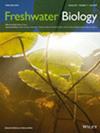湿地水生无脊椎动物分类丰富度测量的挑战与对策
IF 2.7
2区 生物学
Q2 ECOLOGY
引用次数: 0
摘要
生物多样性的测量对于评估生态系统的生态完整性至关重要。然而,充分描述栖息地中存在的生物范围可能具有挑战性,特别是对于分类丰富的无脊椎动物。我们分析了6个大型数据集,这些数据集旨在描述来自不同地区或地点(北美、非洲南部和南美洲)的洼地淡水湿地水生无脊椎动物群落的分类丰富度。其中三个数据集针对大量湿地(57-163个地点),采样一次,其他三个数据集在较长时间(5-23年)内重复采样,但针对的湿地数量较少(10-18年)。我们估计了每个目标区域可能存在的无脊椎动物类群的总数(Chao估计器),而不是每次努力实际收集的丰富度(使用分类群积累曲线)。最雄心勃勃的努力(17个湿地,23年,每年5-6次采样)捕获了研究区域预计出现的95%的水生无脊椎动物类群;其他五种努力都没有捕获到每个研究区域预计的总丰富度的80%以上。研究结果表明,捕获90%或更多的区域分类群确实很费力,不应该成为湿地无脊椎动物取样的主要目标。湿地无脊椎动物采样的目标应该根据实际情况进行调整,因为即使是雄心勃勃的努力,也可能错过多达30%的类群。作为一种潜在的解决方案,我们建议为湿地大型无脊椎动物的评估设定可行的目标。我们建议研究人员在2-3年的时间里对60-80个湿地进行一次或更小的采样,以达到70%的研究区域丰富度目标。本文章由计算机程序翻译,如有差异,请以英文原文为准。
Challenges and Solutions for Measuring Taxonomic Richness of Aquatic Invertebrates in Wetlands
- Measurements of biodiversity are crucial to assessing the ecological integrity of ecosystems. However, adequately describing the range of organisms existing in habitats can be challenging, especially for the taxonomically rich invertebrates.
- We analysed six large datasets designed to describe the taxonomic richness of aquatic invertebrate assemblages in depressional freshwater wetlands from various regions or locations (in North America, southern Africa and South America). Three of the datasets targeted large numbers of wetlands (57–163 sites), sampled once and the other three datasets repeatedly sampled over longer time periods (5–23 years), but targeted a smaller number of wetlands (10–18).
- We estimated the total number of invertebrate taxa that likely existed for each target area (Chao estimator), as opposed to how much of that richness was actually collected by each effort (using taxon-accumulation curves). The most ambitious effort (17 wetlands, 23 years, 5–6 samplings per year) captured 95% of the aquatic invertebrate taxa projected to occur in the study area; none of the other five efforts captured appreciably more than 80% of the projected total richness per study area.
- Findings suggest that capturing 90% or more of regional taxa is truly laborious and should not be a primary goal for efforts to sample the invertebrate fauna in wetlands. Objectives for sampling wetland invertebrates should be tailored to address what is realistic, knowing that as much as 30% of taxa may be missed by even ambitious efforts.
- As a potential solution, we suggest setting feasible objectives for wetlands macroinvertebrate assessments. We recommend researchers try to reach a 70% study area richness target by sampling 60–80 wetlands once or smaller sets of wetlands for 2–3 years.
求助全文
通过发布文献求助,成功后即可免费获取论文全文。
去求助
来源期刊

Freshwater Biology
生物-海洋与淡水生物学
CiteScore
5.90
自引率
3.70%
发文量
162
审稿时长
2 months
期刊介绍:
Freshwater Biology publishes papers on all aspects of the ecology of inland waters, including rivers and lakes, ground waters, flood plains and other freshwater wetlands. We include studies of micro-organisms, algae, macrophytes, invertebrates, fish and other vertebrates, as well as those concerning whole systems and related physical and chemical aspects of the environment, provided that they have clear biological relevance.
Studies may focus at any level in the ecological hierarchy from physiological ecology and animal behaviour, through population dynamics and evolutionary genetics, to community interactions, biogeography and ecosystem functioning. They may also be at any scale: from microhabitat to landscape, and continental to global. Preference is given to research, whether meta-analytical, experimental, theoretical or descriptive, highlighting causal (ecological) mechanisms from which clearly stated hypotheses are derived. Manuscripts with an experimental or conceptual flavour are particularly welcome, as are those or which integrate laboratory and field work, and studies from less well researched areas of the world. Priority is given to submissions that are likely to interest a wide range of readers.
We encourage submission of papers well grounded in ecological theory that deal with issues related to the conservation and management of inland waters. Papers interpreting fundamental research in a way that makes clear its applied, strategic or socio-economic relevance are also welcome.
Review articles (FRESHWATER BIOLOGY REVIEWS) and discussion papers (OPINION) are also invited: these enable authors to publish high-quality material outside the constraints of standard research papers.
 求助内容:
求助内容: 应助结果提醒方式:
应助结果提醒方式:


